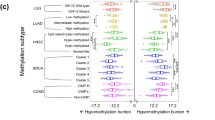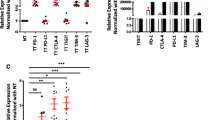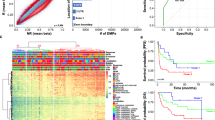Abstract
BACKGROUND
CD155 immune checkpoint has recently emerged as a compelling immunotherapeutic target. Epigenetic DNA methylation changes are recognized as key molecular mechanisms in cancer development. Hence, the identification of methylation markers that are sensitive and specific for breast cancer may improve early detection and predict prognosis. We speculate that CD155 promoter methylation can be a valuable epigenetic biomarker, based upon strong indications for its immunoregulatory functions.
METHODS
Methylation analyses were conducted on 14 CpGs sites in the CD155 promoter region by bisulfite pyrosequencing. To elucidate the related gene expression changes, a transcriptional study using RT-qPCR was performed. Statistical analyses were performed to evaluate correlations of CD155 methylation profiles with mRNA expression together with clinical-pathological features, prognosis and immune infiltrate.
RESULTS
CD155 promoter methylation profile was significantly associated with SBR grade, tumor size, molecular subgroups, HER2 and hormonal receptors expression status. Low CD155 methylation rates correlated with better prognosis in univariate cox proportional hazard analysis and appeared as an independent survival predictor in cox-regression multivariate analysis. Further, methylation changes at CD155 specific CpG sites were consistent with CD155 membranous mRNA isoform expression status. Statistical analyses also showed a significant association with immune Natural Killer cell infiltrate when looking at the CpG7, CpG8, CpG9 and CpG11 sites.
CONCLUSION
Altogether, our results contribute to a better understanding of the impact of CD155 immune checkpoint modality expression in breast tumors, revealing for the first time that specific CpG sites from CD155 promoter may be a potential biomarker in breast cancer monitoring.





Similar content being viewed by others
Availability of data and material
All data generated or analyzed during this study are included in this published article.
Abbreviations
- ACTB:
-
Beta-Actin
- bp:
-
Base pair
- cyt-CD155:
-
Cytoplasmic CD155
- DFS:
-
Disease-Free Survival
- FFPE:
-
Formalin-Fixed and Paraffin-Embedded
- HER2:
-
HER2 positive
- kbp:
-
Kilobase pair
- LA:
-
Luminal A
- LB-Like:
-
Luminal B like
- m-CD155:
-
Membranous CD155
- NK:
-
Natural Killer
- NK-TILs:
-
Tumor-Infiltrating Natural Killer Cell
- OS:
-
Overall Survival
- RT-qPCR:
-
Real-time Quantitative Reverse Transcriptase Polymerase Chain Reaction
- SBR:
-
Scarff-Bloom-Richardson
- TBE:
-
Tris-Borate-EDTA
- TILs:
-
Tumor-Infiltrating Lymphocytes
- TME:
-
Tumor Microenvironment
- TNBC:
-
Triple Negative breast cancer
- TNM:
-
Tumor lymph node and metastases
References
Pardoll DM (2012) The blockade of immune checkpoints in cancer immunotherapy. Nat Rev Cancer 12(4):252–264. https://doi.org/10.1038/nrc3239
Topalian SL, Drake CG, Pardoll DM (2015) Immune checkpoint blockade: a common denominator approach to cancer therapy. Cancer Cell 27(4):450–461. https://doi.org/10.1016/j.ccell.2015.03.001
Sharma P, Allison JP (2015) The future of immune checkpoint therapy. Science 348(6230):56–61. https://doi.org/10.1126/science.aaa8172
Chaudhary B, Elkord E (2016) Regulatory T Cells in the Tumor Microenvironment and Cancer Progression: Role and Therapeutic Targeting. Vaccines (Basel). https://doi.org/10.3390/vaccines4030028
Sasidharan Nair V, Elkord E (2018) Immune checkpoint inhibitors in cancer therapy: a focus on T-regulatory cells. Immunol Cell Biol 96(1):21–33. https://doi.org/10.1111/imcb.1003
Dougall WC, Kurtulus S, Smyth MJ, Anderson AC (2017) TIGIT and CD96: new checkpoint receptor targets for cancer immunotherapy. Immunol Rev 276(1):112–120. https://doi.org/10.1111/imr.12518
Chan CJ et al (2014) The receptors CD96 and CD226 oppose each other in the regulation of natural killer cell functions. Nat Immunol 15(5):431–438. https://doi.org/10.1038/ni.2850
Masson D et al (2001) Overexpression of the CD155 gene in human colorectal carcinoma. Gut 49(2):236–240
Nakai R et al (2010) Overexpression of Necl-5 correlates with unfavorable prognosis in patients with lung adenocarcinoma. Cancer Sci 101(5):1326–1330. https://doi.org/10.1111/j.1349-7006.2010.01530.x
Bevelacqua V et al (2012) Nectin like-5 overexpression correlates with the malignant phenotype in cutaneous melanoma. Oncotarget 3(8):882–892. https://doi.org/10.18632/oncotarget.594
Nishiwada S et al (2015) Clinical significance of CD155 expression in human pancreatic cancer. Anticancer Res 35(4):2287–2297
Sloan KE, Stewart JK, Treloar AF, Matthews RT, Jay DG (2005) CD155/PVR enhances glioma cell dispersal by regulating adhesion signaling and focal adhesion dynamics. Cancer Res 65(23):10930–10937. https://doi.org/10.1158/0008-5472.CAN-05-1890
Stamm H et al (2019) Targeting the TIGIT-PVR immune checkpoint axis as novel therapeutic option in breast cancer. Oncoimmunology 8(12):e1674605. https://doi.org/10.1080/2162402X.2019.1674605
Triki H et al (2019) CD155 expression in human breast cancer: Clinical significance and relevance to natural killer cell infiltration. Life Sci 231:116543. https://doi.org/10.1016/j.lfs.2019.116543
Y.-C. Li et al., (2020) Overexpression of an Immune Checkpoint (CD155) in Breast Cancer Associated with Prognostic Significance and Exhausted Tumor-Infiltrating Lymphocytes: A Cohort Study. Journal of Immunology Research. https://www.hindawi.com/journals/jir/2020/3948928/. Accessed 08 Apr 2020
Excoffon KJDA, Bowers JR, Sharma P (2014) 1. Alternative splicing of viral receptors: A review of the diverse morphologies and physiologies of adenoviral receptors. Recent Res Dev Virol 9:1–24
Koike S et al (1990) The poliovirus receptor protein is produced both as membrane-bound and secreted forms. EMBO J 9(10):3217–3224
Béatrice B et al (2003) Identification of secreted CD155 isoforms. BiochemBiophys Res Commun. 309(1):175–182. https://doi.org/10.1016/s0006-291x(03)01560-2
Lozano E, Dominguez-Villar M, Kuchroo V, Hafler DA (2012) The TIGIT/CD226 axis regulates human T cell function. J Immunol 188(8):3869–3875. https://doi.org/10.4049/jimmunol.1103627
Kulis M, Esteller M (2010) DNA methylation and cancer. Adv Genet 70:27–56. https://doi.org/10.1016/B978-0-12-380866-0.60002-2
Sinčić N, Herceg Z (2011) DNA methylation and cancer: ghosts and angels above the genes. CurrOpin Oncol 23(1):69–76. https://doi.org/10.1097/CCO.0b013e3283412eb4
Wu Y, Sarkissyan M, Vadgama JV (2015) Epigenetics in breast and prostate cancer. Methods Mol Biol 1238:425–466. https://doi.org/10.1007/978-1-4939-1804-1_23
Sasidharan Nair V, El Salhat H, Taha RZ, John A, Ali BR, Elkord E (2018) DNA methylation and repressive H3K9 and H3K27 trimethylation in the promoter regions of PD-1, CTLA-4, TIM-3, LAG-3, TIGIT, and PD-L1 genes in human primary breast cancer. Clin Epigenetics. https://doi.org/10.1186/s13148-018-0512-1
Roulois D, Yau HL, De Carvalho DD (2016) Pharmacological DNA demethylation: Implications for cancer immunotherapy. Oncoimmunology 5(3):e1090077. https://doi.org/10.1080/2162402X.2015.1090077
Maruvada P, Wang W, Wagner PD, Srivastava S (2005) Biomarkers in molecular medicine: cancer detection and diagnosis. Biotechniques. https://doi.org/10.2144/05384su04
Wolff AC et al (2013) Recommendations for human epidermal growth factor receptor 2 testing in breast cancer: American Society of Clinical Oncology/College of American Pathologists clinical practice guideline update. J Clin Oncol 31(31):3997–4013. https://doi.org/10.1200/JCO.2013.50.9984
Bouzidi L et al (2021) Prognostic value of natural killer cells besides tumor infiltrating lymphocytes in breast cancer tissues. Clin Breast Cancer. https://doi.org/10.1016/j.clbc.2021.02.003
Sambrook J, Russell DW (2006) Purification of nucleic acids by extraction with phenol:chloroform. CSH Protoc. 2006(1):169–170. https://doi.org/10.1101/pdb.prot4455
Saiki RK et al (1988) Primer-directed enzymatic amplification of DNA with a thermostable DNA polymerase. Science 239(4839):487–491
Declerck K et al (2017) Interaction between prenatal pesticide exposure and a common polymorphism in the PON1 gene on DNA methylation in genes associated with cardio-metabolic disease risk—an exploratory study. Clin Epigenetics. https://doi.org/10.1186/s13148-017-0336-4
Sun Y et al (2020) Combined evaluation of the expression status of CD155 and TIGIT plays an important role in the prognosis of LUAD (lung adenocarcinoma). Int Immunopharmacol 80:106198. https://doi.org/10.1016/j.intimp.2020.106198
Jones PA, Baylin SB (2007) The epigenomics of cancer. Cell 128(4):683–692. https://doi.org/10.1016/j.cell.2007.01.029
Jones PA (2012) Functions of DNA methylation: islands, start sites, gene bodies and beyond. Nat Rev Genet 13(7):484–492. https://doi.org/10.1038/nrg3230
Gibney ER, Nolan CM (2010) Epigenetics and gene expression. Heredity. https://doi.org/10.1038/hdy.2010.54
Chen G et al (2002) Discordant protein and mRNA expression in lung adenocarcinomas. Mol Cell Proteomics 1(4):304–313. https://doi.org/10.1074/mcp.M200008-MCP200
Yong H et al (2019) CD155 expression and its prognostic value in postoperative patients with breast cancer. Biomed Pharmacother 115:108884. https://doi.org/10.1016/j.biopha.2019.108884
Atsumi S, Matsumine A, Toyoda H, Niimi R, Iino T, Sudo A (2013) Prognostic significance of CD155 mRNA expression in soft tissue sarcomas. Oncol Lett 5(6):1771–1776. https://doi.org/10.3892/ol.2013.1280
Zhao K, Ma L, Feng L, Huang Z, Meng X, Yu J (2021) CD155 Overexpression Correlates With Poor Prognosis in Primary Small Cell Carcinoma of the Esophagus. Front Mol Biosci. https://doi.org/10.3389/fmolb.2020.608404
Wang R-B et al (2020) Overexpression of CD155 is associated with PD-1 and PD-L1 expression on immune cells, rather than tumor cells in the breast cancer microenvironment. World J Clin Cases 8(23):5935–5943. https://doi.org/10.12998/wjcc.v8.i23.5935
“The Cancer Genome Atlas Program - National Cancer Institute,” Jun. 13, 2018. https://www.cancer.gov/about-nci/organization/ccg/research/structural-genomics/tcga. Accessed 20 Feb 2021
Koch A, De Meyer T, Jeschke J, Van Criekinge W (2015) MEXPRESS: visualizing expression, DNA methylation and clinical TCGA data. BMC Genomics 16:636. https://doi.org/10.1186/s12864-015-1847-z
O’Donnell JS, Long GV, Scolyer RA, Teng MWL, Smyth MJ (2017) Resistance to PD1/PDL1 checkpoint inhibition. Cancer Treat Rev 52:71–81. https://doi.org/10.1016/j.ctrv.2016.11.007
O’Donnell JS, Madore J, Li X-Y, Smyth MJ (2020) Tumor intrinsic and extrinsic immune functions of CD155. Semin Cancer Biol 65:189–196. https://doi.org/10.1016/j.semcancer.2019.11.013
Lupo KB, Matosevic S (2020) CD155 immunoregulation as a target for natural killer cell immunotherapy in glioblastoma. J Hematol Oncol 13(1):76. https://doi.org/10.1186/s13045-020-00913-2
Chauvin J-M et al (2015) TIGIT and PD-1 impair tumor antigen–specific CD8+ T cells in melanoma patients. J Clin Invest 125(5):2046–2058. https://doi.org/10.1172/JCI80445
Smazynski J et al (2020) The immune suppressive factors CD155 and PD-L1 show contrasting expression patterns and immune correlates in ovarian and other cancers. Gynecol Oncol 158(1):167–177. https://doi.org/10.1016/j.ygyno.2020.04.689
Huang D-W, Huang M, Lin X-S, Huang Q (2017) CD155 expression and its correlation with clinicopathologic characteristics, angiogenesis, and prognosis in human cholangiocarcinoma. Onco Targets Ther 10:3817–3825. https://doi.org/10.2147/OTT.S141476
Qu P et al (2015) Loss of CD155 expression predicts poor prognosis in hepatocellular carcinoma. Histopathology 66(5):706–714. https://doi.org/10.1111/his.12584
Acknowledgements
We thank our study participants for their contribution to this study. A further thanks goes to the Protein Chemistry, Proteomics and Epigenetic Signaling (PPES), University of Antwerp, team members for their collaboration and valuable contribution. This work was partially supported by ISESCO (Islamic Educational, Scientific and Cultural Organization) Research grant (Ref No. 2148).
Funding
This work was financially supported by ISESCO (Islamic Educational, Scientific and Cultural Organization) Research grant (Ref N°2148).
Author information
Authors and Affiliations
Contributions
HT contributed to data curation, formal analysis, investigation, methodology, software, validation, visualization, writing—original draft, writing—review and editing. KD contributed to formal analysis, software, visualization. SC contributed to data curation, project administration, resources, supervision, validation. KC contributed to data curation, resources. SBH contributed to data curation, resources. WBK contributed to data curation, resources. TS contributed to data curation, resources. AR contributed to formal analysis, project administration, supervision, validation. WVB contributed to project administration, resources, supervision, validation, visualization, writing—review and editing. BC contributed to conceptualization, funding acquisition, investigation, methodology, project administration, resources, supervision, validation, visualization, writing—review and editing.
Corresponding author
Ethics declarations
Conflicts of interest
The authors have no conflicts of interest to declare.
Ethics approval
All procedures performed in studies involving human participants were in accordance with the ethical standards of the institutional and the national research committee of Habib Bourguiba University Hospital and with the 1964 Helsinki declaration and its later amendments or comparable ethical standards. Sampling was made only on patient tissues from tissue library of Pathology Department-Habib Bourguiba Hospital, and no samples were made specifically for the study.
Consent to participate
We have conducted a retrospective study, for this type of study, formal consent is not required.
Consent for publication
All authors reviewed and approved the manuscript for submission.
Additional information
Publisher's Note
Springer Nature remains neutral with regard to jurisdictional claims in published maps and institutional affiliations.
Rights and permissions
About this article
Cite this article
Triki, H., Declerck, K., Charfi, S. et al. Immune checkpoint CD155 promoter methylation profiling reveals cancer-associated behaviors within breast neoplasia. Cancer Immunol Immunother 71, 1139–1155 (2022). https://doi.org/10.1007/s00262-021-03064-6
Received:
Accepted:
Published:
Issue Date:
DOI: https://doi.org/10.1007/s00262-021-03064-6




